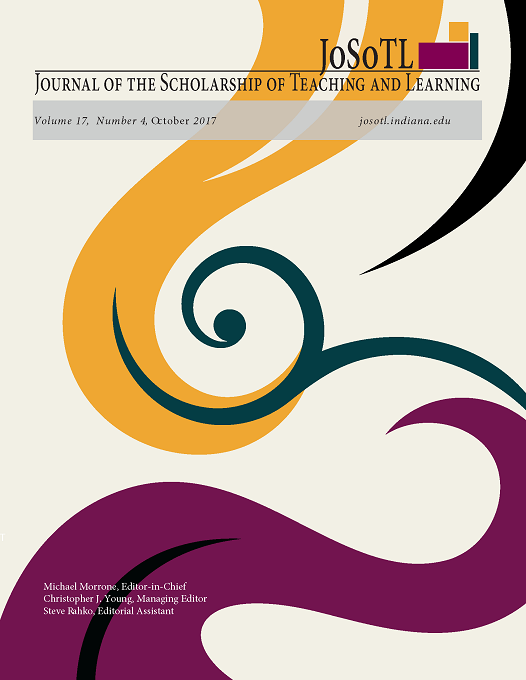Awakening the Learner Within: Purposeful Prompts and Lifelong Learning Measures in a First-Year Composition Course
Main Article Content
Abstract
Lifelong learning skills have been shown to benefit students during and after college. This paper discusses the use of the Effective Lifelong Learning Inventory (ELLI) in a first-year composition course. Reflective writing assignments and pre- and post-semester ELLI data were used to assess student growth as lifelong learners over the course of a semester. Statistically significant gains in lifelong learning dimensions were made by students in the study as compared to those in a control group who received no direct instruction. The authors reflect on the outcomes of the project for students and instructors and question the general assumptions often made about the outcomes of a college education, namely, whether students gain lifelong learning skills simply by virtue of attending college, or is more instruction on these “intangible” qualities needed?
Downloads
Article Details
- Authors retain copyright and grant the Journal of the Scholarship of Teaching and Learning (JoSoTL) right of first publication with the work simultaneously licensed under a Creative Commons Attribution License, (CC-BY) 4.0 International, allowing others to share the work with proper acknowledgement and citation of the work's authorship and initial publication in the Journal of the Scholarship of Teaching and Learning.
- Authors are able to enter separate, additional contractual agreements for the non-exclusive distribution of the journal's published version of the work (e.g., post it to an institutional repository or publish it in a book), with an acknowledgement of its initial publication in the Journal of the Scholarship of Teaching and Learning.
- In pursuit of manuscripts of the highest quality, multiple opportunities for mentoring, and greater reach and citation of JoSoTL publications, JoSoTL encourages authors to share their drafts to seek feedback from relevant communities unless the manuscript is already under review or in the publication queue after being accepted. In other words, to be eligible for publication in JoSoTL, manuscripts should not be shared publicly (e.g., online), while under review (after being initially submitted, or after being revised and resubmitted for reconsideration), or upon notice of acceptance and before publication. Once published, authors are strongly encouraged to share the published version widely, with an acknowledgement of its initial publication in the Journal of the Scholarship of Teaching and Learning.
References
item grit scale. (n.d.). Duckworth Labs, University of Pennsylvania. Retrieved from https://upenn.app.box.com/s/et30heyb2e7keq4t2w8b7c65l230pscn.
Brundin, J. (2015, August 19). To learn more, this high-schooler left the classroom [Audio file]. In nprEd: How learning happens. Retrieved from http://www.npr.org/sections/ed/2015/08/19/432582341/to-learn-more-this-high-schooler-left-the classroom.
Deakin Crick, R., Broadfoot, P., & Claxton, G. (2004). Developing an effective lifelong learning inventory: The ELLI project. Assessment in Education, 11(3), 247-272. http://doi.org/10.1080/0969594042000304582.
Deakin Crick, R., & Yu, G. (2008). Assessing learning dispositions: Is the Effective Lifelong Learning Inventory valid and reliable as a measurement tool? Educational Research, 50(4), 387402. http://doi.org/10.1080/00131880802499886.
Deci, E. L. & Flaste, R. (1996). Why we do what we do: Understanding self-motivation. New York: Penguin.
Duckworth, A. L. (2013, April). The key to success? Grit [Video file]. Retrieved from https://www.ted.com/talks/angela_lee_duckworth_the_key_to_success_grit?.
Dweck, C. S. (2008). Mindset: The new psychology of success. New York: Ballantine.
Dzubak, C. M. (2013). A purposeful pause: The role of active reflection in learning, Synergy: The Online Journal of the Association for the Tutoring Profession, 6. Retrieved from http://www.myatp.org/resources/journal/synergy-volume-6.
Gill, S. & Shaffer, S. C. (2017). Are higher-order thinking skills enough? An exploration of the additive effects of mindfulness-based instruction on traditional instructional practices. Manuscript in preparation.
Head, A. J., Van Hoeck, M., & Garson, D. S. (2015). Lifelong learning in the digital age: A content analysis of recent research on participation. First Monday, 20(2). Retrieved from http://firstmonday.org/ojs/index.php/fm/article/view/5857/4210#author.
Hoops, L.D., Yu, S. L., Burridge, A. B., & Wolters, C. A. (2015). Impact of a student success course on undergraduate academic outcomes. Journal of College Reading and Learning, 45(2), 123-146. doi: 10.1080/10790195.2015.1032041
Kuh, G. D., Kinzie, J., Schuh, J. H., & Whitt, E. J. (2005). Student success in college: Creating conditions that matter. San Francisco: Jossey-Bass.
Mezirow, J. (1990). Fostering critical reflection in adulthood: A guide to transformative and emancipatory learning. San Francisco: Jossey-Bass.
Mezirow, J. (1998). On critical reflection. Adult Education Quarterly, 48(3), 185-198. http://doi.org/10.1177/074171369804800305.
My learning power: Using ELLI in higher education. (2011) ViTaL Partnerships Professional Services, Ltd.
National Center for Education Statistics (2015). The condition of education 2015. US Department of Education. Retrieved from: http://nces.ed.gov/pubs2015/2015144.pdf.
Reason, R.D. (2009). An examination of persistence research through the lens of a comprehensive conceptual framework. Journal of College Student Development, 50(6), 659-682. http://doi.org/10.1353/csd.0.0098.
Saunders, D. B. (2014). Exploring a customer orientation: Free-market logic and college students. Review of Higher Education, 37(2), 197-219. doi:10.1353/rhe.2014.0013
Shaffer, S.C. (2015). Building student capacity for reflective thinking. The Common Good: A SUNY Plattsburgh Journal on Teaching and Learning, 3(1).
Shaffer, S. C., Eshbach, B. E., & Santiago-Blay, J. A. (2015). A dual approach to fostering under-prepared student success: Focusing on doing and becoming. Insight: A Journal of Scholarly Teaching. 10, 79-91.
Smith, J. & A. Spurling. (1999) Lifelong learning: Riding the tiger. New York: Cassell.
Su, Y. (2015). Ensuring the continuum of learning: The role of assessment for lifelong learning. International Review of Education, 61(1), 7-20. http://doi.org10.1007/s11159-015-9465-1.
von Stumm, S., Hell, B., & Chamorro-Premuzic, T. (2011). The hungry mind: Intellectual curiosity is the third pillar of academic performance. Perspectives on Psychological Science, 6(6), 574-588. http://doi.org10.1177/1745691611421204.
